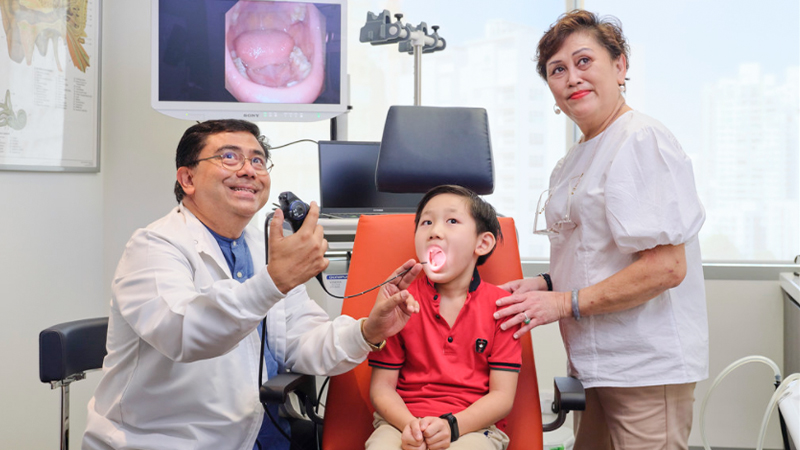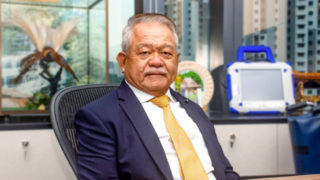Hearing loss and enlarged adenoids are two of the most common ear, nose and throat (ENT) conditions. Here, two ENT specialists in Singapore share the signs to look for and how these conditions can be treated.
#1 Hearing loss
Hearing loss is a condition that occurs when one or both ears are not working properly. It can present right from birth or later in life, at any stage. And it’s not just an elderly condition. Even children who previously had normal hearing can develop hearing loss.
In fact, a frightening number of younger people – specifically, 12- to-35-year-olds – are at risk of developing permanent hearing loss from listening to music and gaming devices at high volumes for prolonged periods of time, says DR REBECCA HEYWOOD, a British ENT specialist surgeon in Singapore, with special expertise in managing complex ear and hearing conditions in adults and children.

In addition to loud noise exposure, some common causes of acquired hearing loss in adults and children include:
- build-up of ear wax;
- ageing;
- infection of the outer or middle ear;
- fluid behind the ear drum (known as “ear glue”); and certain medications that are harmful to the inner ear.
For many people, hearing loss develops quite slowly, making it difficult to distinguish any obvious change in hearing capabilities. For example, someone with mild to moderate hearing loss may not notice that the everyday sounds around them have dulled.
“By the time hearing loss becomes severe, only very loud sounds can be heard and those affected may not even know that people are talking to them at all at a normal conversational level,” says ENT specialist in Singapore, Dr Heywood.

How hearing loss can hurt you
Because hearing loss is an “invisible” condition, it’s all too often disregarded. However, untreated hearing loss can have detrimental effects on all aspects of an individual’s life.
“Life is all about communication, and people with hearing loss have difficulty communicating. Having hearing loss can be extremely lonely and isolating,” says Dr Heywood. “For someone with mild to moderate hearing loss, dinner with family or friends can create feelings of exclusion and loneliness, even while surrounded by loved ones.”
Additionally, people with hearing loss often feel embarrassed about asking others to repeat themselves constantly. Sometimes, they pretend to understand, but miss what’s being said completely. This, of course, poses challenges at school and in the workplace, and everywhere in between. It can take a major toll on personal relationships, leading to social isolation and lack of self-esteem, and even anxiety and depression.
What’s more, Dr Heywood says hearing loss has recently been linked to various health conditions. Elderly people with hearing loss, in particular, have an increased risk of falls, hospitalisation and death, especially due to cardiovascular causes.
Also concerning is the link between hearing loss and memory problems, including an increased risk of dementia. In fact, hearing loss in midlife – not just in old age – has been found to be the largest modifiable risk factor for dementia.
Signs of hearing loss: What to look for at every life stage
With such challenges posed by hearing loss, it’s important to know the red flags to look for at every phase of life.
Babies and toddlers
Parents of babies with hearing loss may notice that their baby doesn’t startle to loud sounds, or won’t turn toward their voice or environmental sounds, or start to babble. Toddlers with hearing loss may have delayed or even absent speech and language development, depending on the degree of their hearing loss.
Children
Kids with hearing loss may:
- not respond when spoken to, particularly if they’re not close to the speaker;
- look at peoples’ faces more when they are being spoken to;
- ask for things to be repeated;
- start turning the TV volume louder; and
- fall behind in school. Parents and teachers may notice that the clarity of the child’s speech has deteriorated, and teachers may complain that the child doesn’t pay attention in class.
Adults
The first thing adults may notice is that they can hear people talking but can’t quite understand what they are saying. This is only made worse with background noise. Family members may notice that an adult with hearing loss needs to turn the TV louder and ask people to repeat things frequently.
Treatment options for hearing loss
Luckily, you don’t have to live with hearing loss. “No matter how bad the hearing loss is, there are treatment options available,” says Dr Heywood. “With the help of an experienced ENT specialist or audiologist, your quality of life can be transformed.”
Inner ear hearing loss can often be managed with a hearing aid. And, thanks to recent advances, there are now smaller, more aesthetically pleasing options with all kinds of technological capabilities to improve sound quality, says Dr Heywood.
Hearing aids, however, won’t prove beneficial in cases where the patient’s speech clarity is too depreciated. This is when patients can benefit from cochlear implants – electronic devices that are surgically implanted into the inner ear so that sound signals can be transmitted directly to the cochlear (auditory) nerve that goes to the brain. Music and phone calls can even be streamed from a smartphone to the implants – and hearing aids too.
Advanced ENT Centre
#07-16 Gleneagles Medical Centre, 6 Napier Road
6471 1031 | advancedent.com.sg
#2 Enlarged adenoids
Adenoids are a cluster of soft lymphoid tissue at the very back of the nasal passage. Together with the tonsils, adenoids play an important role in your child’s lymphatic system, explains DR EUAN MURUGASU, an ENT specialist in Singapore. He’s also a surgeon at Euan’s ENT Surgery and Clinic based at Mount Elizabeth Novena and treats all kinds of ENT conditions in children and adults – from ear infections, hearing loss and tonsillitis to nose bleeds and sleep disordered breathing. Adenoids, he says, are important in the very early years, as they ward off infection by trapping harmful bacteria that your child breathes in through his mouth or nose. But, as children grow older and their bodies find other ways to fend off infection, adenoids begin to shrink and are almost completely gone by the teen years.
The problem with adenoids
While adenoids serve a positive purpose as germ fighters, ENT specialist Dr Murugasu says that they can become problematic if they become enlarged or swollen and obstruct the child’s airway. Sometimes, this happens as a result of allergies, inflammation or infection. In fact, he says that, in the US, adenoids are sometimes referred to as the “sewer” of the nose, as bacteria may infect and colonise the tissues.
Luckily, there are signs you can look for that can indicate your child’s airway is affected by larger-than-usual adenoids. You may notice that your child is experiencing:
- trouble breathing through the nose;
- mouth breathing, which can lead to a dry mouth and lips;
- noisy breathing;
- bad breath;
- snoring;
- obstructive sleep apnoea;
- frequent or chronic nose and sinus infections; and
- ear infections, middle ear fluid and hearing loss.
Of course, these symptoms do not always mean that a child has enlarged adenoids. But, if you notice that your child is presenting with any of these symptoms, it’s a good idea see your family doctor or paediatrician. He or she can then refer you to an ENT specialist for further diagnosis and treatment.
“At your visit, an ENT doctor will ask about and check your child’s ears, nose and throat, and feel the neck along the jaw. To get a really close look, the doctor might order x-rays or look into the nasal passage with a tiny telescope, called a naso-endoscopy,” says Dr Murugasu.
Treatment for enlarged adenoids
For a suspected allergy, nasal steroids can be prescribed to reduce the swelling. However, if the problem persists, surgery may be necessary to remove the adenoids.
The surgical removal of adenoids is called an adenoidectomy. It is one of the most common ENT procedures performed on children, along with tonsil removal. These days, adenoidectomies can be performed as minimally invasive procedures, says Dr Murugasu. In his practice, he prefers the coblation technique, which uses gentle low-temperature radiofrequency technology to remove the targeted tissue with minimal damage to the surrounding tissue, as compared to the more traditional surgical techniques. The coblation system uses an endoscopic wand to access the back of the throat without requiring any incisions.
In most cases, the procedure is quick, and the child can usually go home on the same day, given that there are no complications.
Euan’s ENT Surgery & Clinic
#10-31 Mount Elizabeth Novena Specialist Centre, 38 Irrawaddy Road
6694 4282 | euansent.com
This article first appeared in the May 2022 edition of Expat Living. You can purchase the latest issue or subscribe, so you never miss a copy!







